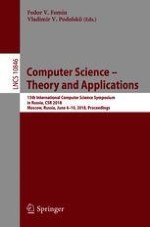2018 | Book
Computer Science – Theory and Applications
13th International Computer Science Symposium in Russia, CSR 2018, Moscow, Russia, June 6–10, 2018, Proceedings
Editors: Prof. Dr. Fedor V. Fomin, Vladimir V. Podolskii
Publisher: Springer International Publishing
Book Series : Lecture Notes in Computer Science
